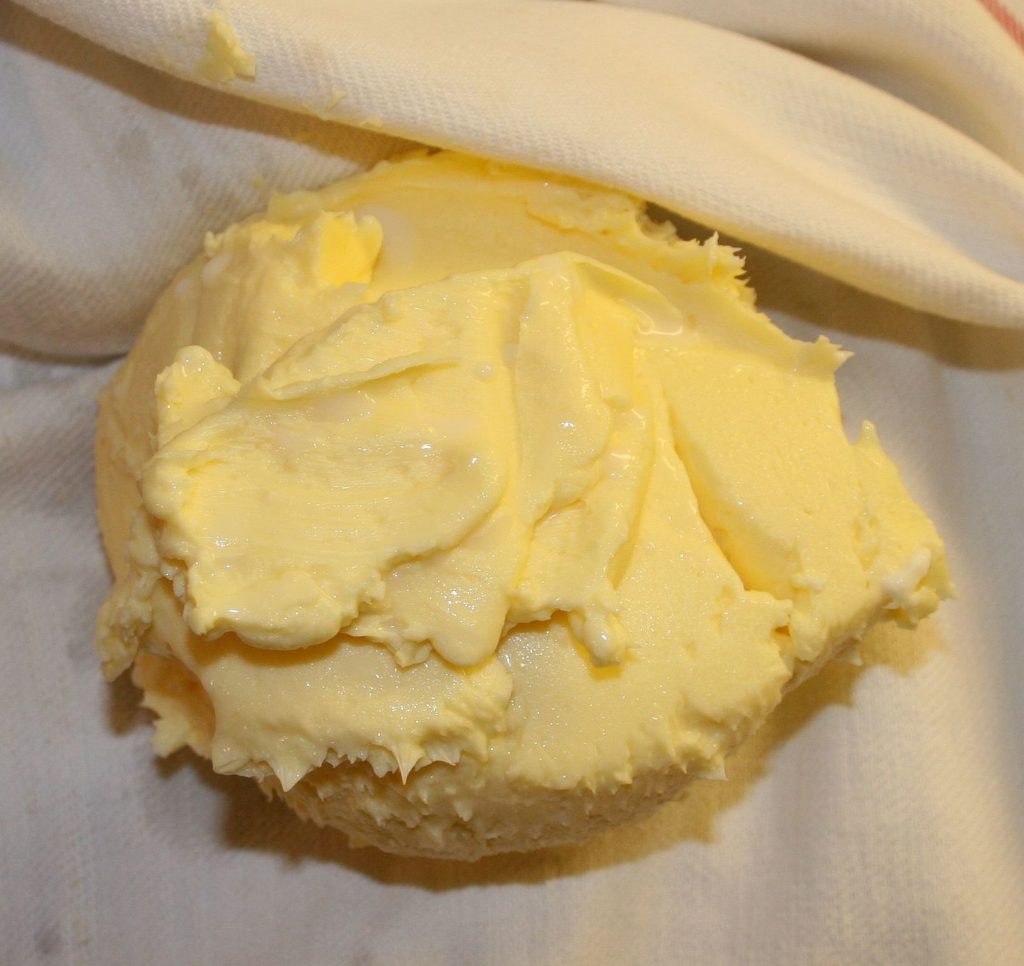Homemade fermented butter is rich, silky, creamy, with a slightly tangy twist. Cultured butter has similar uses as standard butter, just with more character. Cultured butter contains lots of good bacteria.
Fermented cream
I sometimes order raw cream from a trusted farmer and by the time I receive the cream it has already started to ferment naturally. This can be seen from the thickness of the cream; it’s not pourable and has a slightly tangy flavour.
Butter from unfermented cream is sometimes called “sweet cream butter” i.e. it has not be allowed to sour or ferment.
Raw cream naturally ferments
Raw cream (unpasteurized) naturally contains bacteria that convert milk sugars into lactic acid and other compounds. After a day or two at room temperature, raw cream turns thick and becomes similar to crème fraiche. It’s like a thick, fresh, tangy, soured cream.
The fermentation process produces several aroma compounds like diacetyl, thus creating a full-flavored and more “buttery” taste. What if you can’t get raw cream? You can also ferment standard cream from the grocery store.
Using standard cream from the grocery store
You can buy a culture starter containing bacteria you can add to the cream. This allows the cream to ferment during 12-24 hours, depending on the temperature.
Many culture starters includes Lactococcus and Leuconostoc bacteria strains, though other bacteria are often also included. Here are two examples:
Homemade fermented butter
Here I used 3 quarts (3 liters) of cultured cream. The yield was 3 pounds (1.5 kg) of fermented butter. So you get about half the amount of butter compared to the amount of cream used.
Ingredients
- Full-fat fermented cream
- A food processor
Time to prepare: A batch usually takes 30 minutes until the butter is ready and packed in jars.
1. Churning fermented cream
What about the claim that the temperature of the cream determines how long it takes until butter forms?
I decided to test this with a few batches of fermented cream. Though not a scientific study, the result gives a hint.
1. Cold cream: When the cream was taken from the fridge, it took 22 minutes in the food processor until it finally turned into butter.
2. Cool cream: After about two hours in room temperature, it took only 3 minutes until butter had formed.
3. Room temperature: When I left the fermented cream at room temperature during the night, it took only 1 minute and 15 seconds until butter was formed!
When the cream thickens, slow down the food processor. The butter is heavy and you might end up splashing buttermilk all around the kitchen (happened to me a few times).
2. Remove the buttermilk
Buttermilk is a low-fat leftover product, great to use in baking . Use a strainer to separate the butter still left in the buttermilk.
Pour the buttermilk into another bowl to deal with it later. You’re not done yet with the butter.
There’s still some buttermilk left in the butter and this must be removed. The less liquid that remains in the butter the better. Buttermilk adds an unwanted taste and spoils faster than butter so remove as much as you can. How?
By kneading and rinsing!
3. Wash the butter
Knead the butter under cold water for a few minutes to work out the remaining buttermilk. This is important as it makes butter taste better, stay fresh longer, and have a nicer texture. Remove as much buttermilk residue as possible. You can also put the butter in a cloth and squeeze out the buttermilk.
4. Adding taste and color
Add salt. How much is a matter of taste. I mostly use sea salt. Fermented butter has a full, buttery taste and it great just by itself. However, you can also add flavor.
Try adding curry, red, hot peppers, cinnamon, lemon, or even bacon. Here I added fresh coriander leaves. The butter can still be frozen with the flavoring.
5. Storing fermented butter
Try making butter rolls in wax paper which can be stored in the fridge. Or use air-tight jars. The butter can be stored for a few weeks in a fridge.
In a freezer the butter can be saved for months. Take it out from the freezer and put in in the fridge a few hours before you need it.
Problems
In the autumn and early winter, it might happen that the cream won’t churn. This is because some cows go through cycles which at the end of summer changes the milk composition. This has happened to me a few times and it wasn’t easy to figure out why.
Enjoy
For those on a keto diet, cultured butter is an excellent source of good fats.
In any case, homemade fermented butter is addictive.
